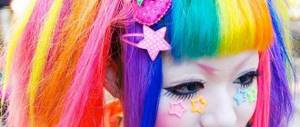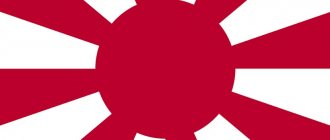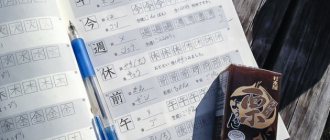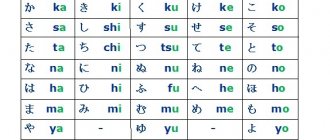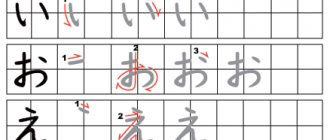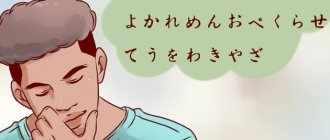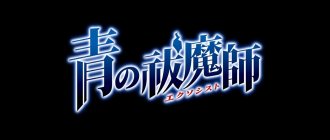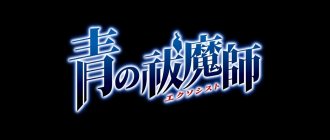Changing the meaning of color words
Those who study Japanese are surprised by the “blue” traffic lights.
When you remember that "green" is midori and "blue" is ao, it is quite strange to learn that green traffic lights at intersections in Japan are called ao-shingo:. We see that even completely ordinary words may not have an unambiguous translation - the permissive signal of a Japanese traffic light is called ao, which can mean either blue or green. Ao is one of the oldest color words in the Japanese language and has had a very wide range of meanings. Some words that are still in common use today use ao to denote the color of new greenery in spring - such as aoba (green/young foliage), aona (green leafy vegetables), aomame (green beans or soybean pods), and the name of Aomori prefecture, "green forest,” which, according to one version, is associated with the juniper thickets that covered a small hill where the prefectural capital is now located. The word ao has historically been applied to a variety of shades extending into other colors, including black, white and grey.
The meanings of words can change in surprising ways and cause confusion. In the oldest Japanese texts, ao and aka (“red” in modern parlance) indicated brightness. Kuro (black) and shiro (white) denoted darkness and light, while ao was used for the darker shades and aka for the brighter shades in between. Just as kuro (black) and kurai (dark) have a common origin, so aka (red) is etymologically related to akarui (light).
This linguistic uncertainty continued for a long time, and ao retained the meaning of "green" by the time traffic lights were introduced. The first electric traffic light was installed in the Hibiya area of Tokyo in 1930. It was imported from the USA and came in three standard colors. The original laws defined the permissive color as midori, “green,” but the people called it ao, and this name stuck. Subsequently, and in legislation in 1947, the permissive signal began to be called aosingo:.
Black
Black (黒いkuroi)
) is associated with something powerful and invincible. It is for this reason that a black belt in judo and karate is a sign of the highest skill. Black also has a familiar connection with evil and destruction. In Japanese, just like in Russian, you can say about a person that he has a “black heart”, and the meaning will be the same. Black is also the color of mourning, especially if it is not diluted with other colors. Association with funerals is also common. But black became the “official” color under the influence of the West, from where the strict black suit came to Japan.
Colorful traditions
Extensive borrowing of vocabulary (gairaigo) from the English language also affected words denoting colors and shapes. Perhaps buru: (blue) and guri:n (green) will not replace ao and midori, although these words can be heard often now, but orenji (orange) seems to be used much more often than daidai, taking its name from another citrus fruit. Pink (pink) has also firmly entered the language, largely replacing momo (peach).
The Japanese color shu (cinnabar) is sometimes translated as "red" or "orange", while in Japan and other East Asian countries it plays a special role and has a special word for it. Typically, the torii gates of Shinto shrines are painted this color, boxes of Syuniku paint are worn along with personal seals of the Inkan, and ink of this color is used by calligraphy teachers when inscribing the work of students. Lacquerware often comes in this color.
Vermilion colored torii gate at Nezu Shrine in Tokyo
The color shu is probably the most visible to Westerners, but there are many other colors that are deeply rooted in tradition in Japan. Murasaki (purple) has long been the color of dress for the ruling class. During the Heian period (794-1192), the pale purple flowers of fuji (wisteria) were often celebrated, perhaps also due to associations with the powerful aristocratic house of Fujiwara (lit. "field of wisteria"). The writer Sei Shonagon, who lived at the turn of the 10th and 11th centuries, repeatedly admires these flowers. For example, in section “88. That which is magnificent" in her famous "Notes at the Head of the Head" she mentions "wisteria flowers of wonderful color, falling in long clusters from pine branches" (translated by V. Markova).
The special attitude of the Heian aristocracy to color is also manifested in the women's costume of the aristocrats, juni-hitoe, “twelve-layer robes,” worn by the ladies of the court. The number of layers in reality could be different and reach up to twenty. The colors of the garments were visible on the sleeves and hem, which were shortened at the top layers, and the creation of such ensembles was a form of art and demonstrated the taste of the wearer. There were complex rules that determined color combinations depending on the time of year, situation and status of the lady.
A modern analogue of such rules is the Shikisai Kentei exam, “Exam for (knowledge of) flowers.” The organization conducting it creates multiple-answer questions for designers and artists and thus defines standards. Some of the questions also relate to the exact determination of shades of colors traditional for Japanese culture, established by the Industrial Standards Committee of Japan.
Standardization, of course, simplifies life, but the beauty of a language lies also in its features. To speakers of other languages, a “blue” traffic light may seem strange, but such differences force us to look at the world from a new angle and allow us to see it from a broader perspective.
Some traditional Japanese colors
| beni (raspberry) | moegi (yellowish green) |
| momo (peach) | hanada (light blue) |
| syu (cinnabar) | ai (indigo) |
| daidai (orange) | Ruri (lapis lazuli) |
| yamabuki (kerria) | fuji (wisteria) |
| uguisu (warbler) | nezumi (mouse) |
Note: The table shows shades determined by the Japanese Industrial Standards Committee. Historically, these words could refer to different shades, especially those named after dyes, since the details of the fabric dyeing process greatly affect the color. They may also look different on different monitors.
Banner photo: “Blue” Aosingo traffic light against the backdrop of aoba, young leaves in early summer.
(Article in English published June 3, 2021)
Peach, green and closet color: traditional Japanese colors
What subtext is hidden behind the colors of the kimonos of beauties from the prints of the Heian and Edo eras? What was the emperor’s personal color and why did the aristocrats establish a monopoly on a number of bright and rich shades? We'll tell you here in a short guide to traditional Japanese flowers.
Under traditional flowers, or dento:shoku
(伝統色), refers to a range of shades that have been used since ancient times in Japan in the production of textiles and clothing, in decorative and applied arts, in painting, etc. Such shades are often found in prints and literature, and it is not surprising, because there is a cultural background behind them, and the mention of a certain color can say a lot to native speakers. For example, the phrase “his head was crowned with a purple headdress,” found in a text from the Heian era (794–1185), ambiguously hinted at the origin and status of the person in question.
It is difficult to say definitively how many colors are considered “traditional”, but there are clearly more of them than those to which we are accustomed.
But it all started long before purple and other violet shades. The oldest colors that the Japanese began to widely use are considered to be the quartet of red, blue (or a spectrum of bluish-greenish shades), black and white.
Even in modern Japanese the importance of these colors can be traced. Most flower names in Japanese are formed using the word 色iro
“color”: 茶色
cha-iro
“brown”、灰色
hai-iro
“gray”.
And only these four colors do not need further clarification and are simply called 赤いakai
, 青い
aoi
, 黒い
kura
, 白い
shira
.
The importance of this set of colors is also indicated by Japanese proper names: if a color is mentioned in the surname, most likely it will be one of the four listed above. They also appear more often in proverbs and sayings. In addition, it is these four colors that form stable combinations with the hieroglyph 真 (“true”, “pure”): 真っ赤makka
“bright red” and 真っ青
masao
“rich blue”, 真っ黒
makkuro
“completely black”, 真っ白
massiro
“snow white”.
However, the perception of colors by the ancient Japanese was quite different from our modern one. It is believed that these four words, which today we perceive as the names of specific colors, initially indicated not shades, but the degree of brightness. Yes, okay
could actually mean "light",
kuroi
- "dark",
siro
- "bright", and
aoi
- "pale".
Therefore, the Japanese, looking at the shining sun at its zenith, can say 真っ赤な太陽makka-na taiyo:,
which will indicate exactly the brightness, and not the scarlet hue.
The diverse nature of the Japanese archipelago with its humid climate could not help but be reflected in the Japanese language, and gradually the Japanese began to invent more and more shade names. A significant part of the names were invented starting from the Kofun era (250–538).
Monopoly on colors
Until a certain point, the colors used by the Japanese in everyday life were, for the most part, accessible to everyone. Prince Shotoku hastened to correct this, who in 603 (Asuka era, 538–710) introduced the Twelve Ranks System. She classified the Japanese nobility into twelve grades and ordered that aristocrats of each rank wear headdresses of their own color. Prince Shotoku borrowed his system, not surprisingly, from China, and in this new hierarchy one of the fundamental concepts of Chinese philosophy could be traced with the naked eye - the concept of the five elements, or Wu-hsing.
Wu-sing interpreted the five elements, namely wood, fire, earth, metal and water, as the main elements of the universe. These elements corresponded to the ancient colors already familiar to us: blue/green like wood, red like fire, metal like white and water like black, but the concept of Wu-sin made one addition. She brought in yellow to match the earth. This is how the yellow color came to Japan and became one of the most important colors (we’ll talk about how important later), along with the four most ancient shades.
Along with the twelve ranks, the Shotoku system introduced “forbidden colors” (禁色kinjiki
), which were allowed to be worn only by those who were assigned a high aristocratic rank.
Commoners were prohibited from using kinjiki. The only exceptions could be those who received permission to wear some color from the emperor himself. The remaining colors, that is, those that could be worn by everyone, regardless of origin and rank, were called yurushiiro
(許し色) - “permitted colors.”
One of the winter combinations of kasane no irome “Under the Snow” is a combination of white and pink plum color.
Aristocrats of the Heian era had to follow strict rules regarding colors and outfits, and one of them was the observance of color combinations in clothing - 襲の色目kasane no irome
. This concept can be translated as “layer colors”. The Heian nobility, especially the aristocrats, combined the colors of the many layers of their clothing in a certain way depending on the seasons, and thus the combinations of kasane no irome appeared.
The twelve rank system was not the only set of laws that imposed restrictions on the use of colors. Prohibited and permitted colors have varied over time, but in most cases the prohibited colors are the following.
Prohibited colors
The most forbidden of all the forbidden flowers was “ sumac color.”
", or 黄櫨染
ko: rozen
, - it could only be worn by the emperor. This color still remains an attribute of Japanese monarchs, and the outer ceremonial clothing worn by emperors upon accession to the throne is today painted exclusively in this yellow-brown-orange shade, close to ocher.
Sumac became the personal color of the Japanese emperors a little later than the Shotoku rank system was introduced - the ceremonial clothes of monarchs began to be dyed in this color starting from the Heian era (794-1185), which echoes a similar tradition in China.
The next most inaccessible color to both ordinary people and the nobility was yellow-red color
(黄丹
o:dan
,
o:ni
). It could only be worn by Japanese crown princes, and during ceremonies they invariably wore an outer robe of this color.
Some colors could be banned only because they were made using the same ingredients and were too similar to shades that were already considered prohibited. One of these flowers was the color of gardenias
(支子色
kutinashi-iro
). Gardenias were also a major ingredient in the production of o:dan dye, reserved for Japanese crown princes, and although a different composition was used to achieve the gardenia color, the shades were considered too similar and the color of gardenias also became prohibited.
Pale green
(
acorn) color
(青白橡
aoshiro-tsurubami
, or 麹塵
kikujin
) was quite popular at court. It was worn by lords, samurai, sometimes even servants, as well as the emperor himself. Because emperors' outerwear was often dyed this shade for special occasions, it has been suggested that at some points in history the pale green was only available to the monarch. In Heian literature, this shade appears simply as 青色 (“green” or “blue”).
Dark purple color
(深紫
fukamurasaki
,
kokimurasaki
) has long been considered the color of the Japanese nobility. It was made from the roots of a Japanese plant of the sparrow genus, a rather expensive ingredient. The more times the fabric was dyed with the dye, the more saturated the shade became, making the fukamurasaki color even more rare and valuable.
Pale red (acorn) color
(赤白橡
akasiro-tsurubami
) is another “imperial color”, which, in addition to the current monarch, could also be worn by ex-emperors. In the second half of the Heian era, regents and advisors were allowed to wear robes of this color during banquets and trips, but only on the condition that the emperor's costume on that day was of a different color. In the literature of the Heian era (794–1185), this shade of pale red was meant by “red color” (赤色).
Dark red color
(深緋
fukahi
,
kokihi
,
kokiake
) were worn by mid-level dignitaries, and gradually it became associated with them. It could also be seen on samurai - for example, in “The Tale of the House of Taira” dark red armor is mentioned.
Dark sappan color
(蘇芳
suo:)
was also worn exclusively by the nobility in the Heian era (794–1185). This shade was achieved thanks to sappan (mahogany) wood. In the collection of instructive stories "Konjaku-monogatari" this color meant the color of blood that was about to coagulate.
All other Japanese could wear the permitted colors, but what could you do if you really, really wanted to wear a scarlet or purple kimono, but you couldn’t? Here ingenuity came to the aid of people from among the people. By mixing different dyes, they achieved similar shades, usually representing less saturated and lighter versions of the forbidden colors, which could not be faulted. For example, take the already mentioned dark red shade of fukahi. Mahogany, its main component, was a cheaper material than sparrow root, which was used to make the purple dye. However, mahogany provided a similar deep undertone and was used to achieve those forbidden and expensive, yet coveted purple shades. Thanks to similar experiments, the so-called “false purple” (偽紫nise-murasaki)
) and other fake shades.
During the Meiji era (1868–1912), along with the class system, the ban on people of “low birth” wearing certain colors was also abolished. Only the sumac color of the emperor and the yellow-red color of the crown princes remained untouched. They remain inaccessible to ordinary people today.
Even without knowing the distinctive features of the imperial costume, you can now identify the Japanese monarch in the engraving. Meet, for example, Emperor Go-Daigo and, of course, his sumac-colored robe.
But both modern Japanese and their ancestors had plenty to choose from. It is quite difficult to estimate the number of colors that are considered traditional in Japan: numbers range from 300 to 500. Each traditional color has its own name, associated mainly with the names of plants and animals, parts of which were used to make the dye. It is quite difficult to find analogues for such colors, and the literal translation of their names can cause a slight shock. Here are a few of our favorites:
海老茶 ebitya – literally “shrimp tea color”. Already in the Meiji era, it was often used in the uniform skirts of female students. There is another way to write the word – 葡萄茶, “grape tea”, which sounds less wild.
This beautiful aquamarine-turquoise color has an even more mysterious name in Japanese. You are ready? This is 納戸色 nando-iro - “closet color”.
Literally, the name of the shade 鬱金色 ukon-iro can be translated as “depressive gold.” But if you look closely at the history of this name, it turns out that 鬱金 is “turmeric”, and the color itself was not associated with depression (the modern meaning of the kanji 鬱), but with money and enrichment.
There's not much to say about the shade 鴨の羽色 (kamo-no-ha iro), except that the name "duck wing color" is quite cute.
Of course, there is a place for poetry in the names of traditional Japanese flowers. This shade, for example, is called 千歳緑 chitose-midori - “thousand-year green”. Who wouldn't want to try one on themselves?
These are just a few colors from the widest palette of Japanese traditional colors. You can find out more about them here and here. Traditional colors are still actively used in fashion and art today, you just need to take a closer look. Write which shade you liked the most!
Sources:
日本語の色の言葉は4色しかなかった?
日本の伝統色とは?
日本人の美の心!日本の色
有職の「かさね色目」
Japanese Traditional Colors
Yellow-red
Only the Crown Prince of Japan can wear clothes of this color. This shade is prohibited for all Japanese except the heir to the throne.
The fight against drowsiness and daydreaming: forecast from Vasilisa Volodina for the week
Tamara Globa reported which zodiac signs will be especially lucky in March
No kefir: a nutritionist dispelled the popular myth about evening meals
White
White (白いsiro
) is a very controversial color.
On the one hand, it carries the meaning of something sacred, a blessing. It’s not for nothing that there is so much of it on the flag, and traditional wedding robes are of this color. However, at the same time, white is associated with death and mourning. So, before a Buddhist funeral, the deceased is dressed in special white clothes called 白装束shirosho:zoku
.
Japanese attitude towards color
At all times, the Japanese have attached great importance to the color of clothing. They distinguished more than 1,100 shades, each of which had its own name and meaning.
The color of clothing indicated a person's status in society. Wealthy people from the upper classes wore brightly colored outfits. These shades were prohibited for those who belonged to the lower stratum of society.
Ordinary people wore clothes of dull colors. But they also wanted to dress brightly. For this purpose, they used tea-ash shades, which were not prohibited. Such colors were called “forgivable.”
In modern Japan, bans on certain colors are not enshrined in law. But many residents of the country continue to observe them. Therefore, the traveler should familiarize himself with the color taboos of the Japanese.
Sausage contributes to weight gain: foods you should avoid after 30
Step-by-step recipe for making a delicate dessert: fragrant pomegranate cakes
The psychic told us what rituals to attract love and money on Maslenitsa
